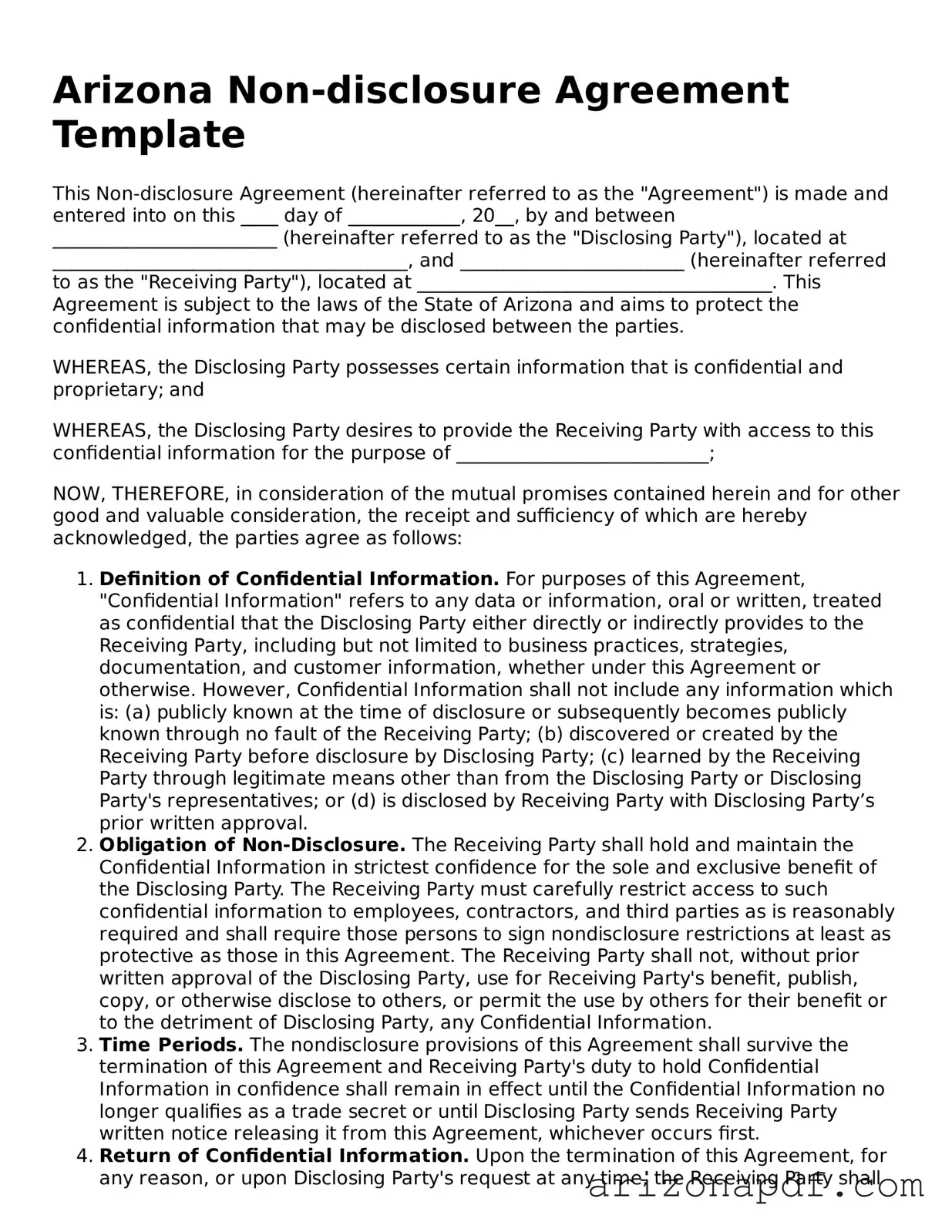Arizona Non-disclosure Agreement Template
This Non-disclosure Agreement (hereinafter referred to as the "Agreement") is made and entered into on this ____ day of ____________, 20__, by and between ________________________ (hereinafter referred to as the "Disclosing Party"), located at ______________________________________, and ________________________ (hereinafter referred to as the "Receiving Party"), located at ______________________________________. This Agreement is subject to the laws of the State of Arizona and aims to protect the confidential information that may be disclosed between the parties.
WHEREAS, the Disclosing Party possesses certain information that is confidential and proprietary; and
WHEREAS, the Disclosing Party desires to provide the Receiving Party with access to this confidential information for the purpose of ___________________________;
NOW, THEREFORE, in consideration of the mutual promises contained herein and for other good and valuable consideration, the receipt and sufficiency of which are hereby acknowledged, the parties agree as follows:
- Definition of Confidential Information. For purposes of this Agreement, "Confidential Information" refers to any data or information, oral or written, treated as confidential that the Disclosing Party either directly or indirectly provides to the Receiving Party, including but not limited to business practices, strategies, documentation, and customer information, whether under this Agreement or otherwise. However, Confidential Information shall not include any information which is: (a) publicly known at the time of disclosure or subsequently becomes publicly known through no fault of the Receiving Party; (b) discovered or created by the Receiving Party before disclosure by Disclosing Party; (c) learned by the Receiving Party through legitimate means other than from the Disclosing Party or Disclosing Party's representatives; or (d) is disclosed by Receiving Party with Disclosing Party’s prior written approval.
- Obligation of Non-Disclosure. The Receiving Party shall hold and maintain the Confidential Information in strictest confidence for the sole and exclusive benefit of the Disclosing Party. The Receiving Party must carefully restrict access to such confidential information to employees, contractors, and third parties as is reasonably required and shall require those persons to sign nondisclosure restrictions at least as protective as those in this Agreement. The Receiving Party shall not, without prior written approval of the Disclosing Party, use for Receiving Party's benefit, publish, copy, or otherwise disclose to others, or permit the use by others for their benefit or to the detriment of Disclosing Party, any Confidential Information.
- Time Periods. The nondisclosure provisions of this Agreement shall survive the termination of this Agreement and Receiving Party's duty to hold Confidential Information in confidence shall remain in effect until the Confidential Information no longer qualifies as a trade secret or until Disclosing Party sends Receiving Party written notice releasing it from this Agreement, whichever occurs first.
- Return of Confidential Information. Upon the termination of this Agreement, for any reason, or upon Disclosing Party's request at any time, the Receiving Party shall immediately return all copies of Confidential Information received from Disclosing Party, whether in written, electronic, or other form or media, and shall also destroy all notes, analyses, or other documents prepared by Receiving Party that contain or otherwise reflect Confidential Information.
- Remedies. Both parties acknowledge and agree that due to the unique nature of the Confidential Information, any breach of this Agreement would result in irreparable harm to the Disclosing Party for which damages alone would not be an adequate remedy. Consequently, the Disclosing Party shall be entitled to seek equitable relief, including injunction and specific performance, as a remedy for any breach or anticipated breach. Such remedies shall not be deemed the exclusive remedies for a breach of this Agreement but shall be in addition to all other remedies available under applicable law or in equity.
- Jurisdiction and Disputes. This Agreement shall be governed by and construed in accordance with the laws of the State of Arizona, without regard to its conflict of law principles. Any disputes under this Agreement may be brought in the state courts and the Federal courts located in the state of Arizona, and both parties consent to the jurisdiction of such courts.
- Entire Agreement. This Agreement constitutes the entire agreement between the Receiving Party and the Disclosing Party regarding the subject matter hereof and supersedes all prior or contemporaneous agreements, understandings, and communication, whether written or oral. This Agreement may only be amended, modified or supplemented by an agreement in writing signed by each party hereto.
IN WITNESS WHEREOF, the parties hereto have executed this Agreement as of the date first above written.
DISCLOSING PARTY:
Signature: ______________________________________
Name: __________________________________________
Title: __________________________________________
Date: ___________________________________________
RECEIVING PARTY:
Signature: ______________________________________
Name: __________________________________________
Title: __________________________________________
Date: ___________________________________________
